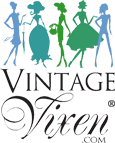When Was The British Crown Colony of Hong Kong?
The more you poke around vintage clothing shops, the more you notice the labels. There's one rather showy descriptor on some labels that may seem a bit mysterious at first. When you read these words - Made In The British Crown Colony Of Hong Kong - you may wonder where that is, or more likely, when that is.

Common labels seen in British Hong Kong imports of the 50s & 60s.
Hong Kong is an island off China, and was in the Chinese domain for most of its history. However, due to some scuffles over opium in the 1800s, the Chinese ceded rights to this island to Britain. From then on, citizens of Hong Kong were technically part of the British empire. This colonization prompted more trade between Hong Kong and the Western world. But this political decision was made in the 1800s, and "made in the British Crown Colony" labels are much later, usually from the late 1950s & early 1960s.
So why did these labels suddenly crop up in vintage clothes of the 50s & 60s?
When Hong Kong became a British colony, bold brocaded labels like you see in the mid 20th century were expensive. In fact, few clothing labels existed at all in the 1800s. Only high-end shops spent on them, and they were small - too small for such long text.
Additionally, the culture of the Victorian era, while it allowed for things exotic, didn't seem too focused on the particular source of an Asian import. The hand-embroidered shawls and kimonos could simply be "from the Orient". Their highly skilled details and Eastern construction were enough to set them apart. More specific information like a label was unnecessary for a Victorian fashionista.
After the turn of the century, the world went through two epic wars and a depression. Not the best time for selling showy imports to the masses. And garment labels, while much more common, were still smallish and not a key marketing tool (unless you were buying from a couturier or the occasional forward-thinking boutique). This lack of technology & marketing was part of Hong Kong's early 20th century history, but it was soon to change.
Labor and fabrics were cheap in Hong Kong, and British tariffs were lenient. There was great interest in manufacture on the island, and by the 1940s, a budding garment industry developed with focus on Western styles due to the British colonial influence.
It wasn't until the Baby Boomer generation that label-focused status clothing began to become a widespread phenomenon. Women no longer had to wish for the clothes they saw their Hollywood counterparts wear. Post World War II, they had plentiful access to better designs and fabrics, and they looked to Hong Kong (among other markets) to supply it. Women often preferred Asian imports as they had superior finishing and beadwork, a highly popular detail in 50s & 60s formal wear.

Popular styles from British Hong Kong included beaded sweaters and dresses, wicker bags, and tailored silk suits.
And by this time, the Hong Kong garment industry was thriving. The patterns had been perfected, and more sophisticated equipment had been imported to the colony, including label machines. By the late 1950s, labels had caught up to match industry maturation - they'd grown larger and more detailed, with graphics brocaded in multiple colors. They'd also become a status symbol of the upper crust.
During this period, one posh boutique took to sewing its store label into coats upside-down, so that when the coat was shrugged off onto a club chair, it could easily be read by her friends nearby.

Designers sent their ready-to-wear lines overseas for mass production in one of Hong Kong's many factories.
And alongside the store label was often an imported label, like those from the island of Hong Kong, which remained a British colony until 1997. Its popularity as a marketing tool lessened by the late 1960s. At this point, markets began to focus on casual wear for daily living, and there was no place for the cost of fancy brocade labels in tees and leisure suits. But that key phrase - made in the British Crown Colony of Hong Kong - lingered until the 1980s in designer labels, and remains sewn into many a vintage clothing collector's closet.
